The life cycle of a butterfly always surprises me. I always thinking about how a wingless caterpillar metamorphoses into an adult butterfly. This article is covered with the butterfly metamorphosis and also the whole life cycle of a butterfly. To know about the butterfly life cycle I observed a butterfly cycle. The butterfly lifespan goes through four stages: egg, larva, pupa, and finally the adult butterfly. There are various species of butterflies around the world. Different species take different periods to complete the life cycle. Lime swallowtail butterfly takes approximately nine to fifteen days to become an adult butterfly. But there are also some butterflies that need one month to a whole year to turns into an adult butterflies.
Adult Butterfly Image captured by: Arrian Azzim
Butterfly Matings:
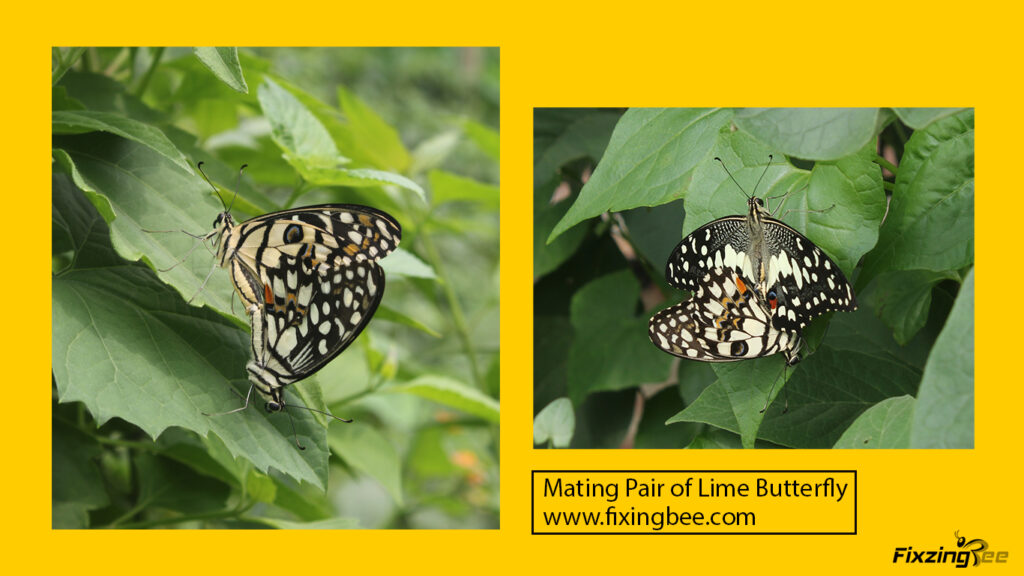
Before describing the stages of a butterfly we need to know that how a butterfly mates. Butterfly find out their mates according to their color and the internal sound. As well as pheromone hormone also helps to find out. Some male butterflies come close to the female butterflies and dance in order to attract them. This stage is called courtship. If the male butterfly manages to attract them then the female butterfly allows the male to go on matting.
Stages of butterfly:
Butterflies need four stages to turn into adult butterflies. Butterfly metamorphosis happens at these four stages. The four stages of butterfly are:
The First Stage: (Egg Laying)-
The life cycle of a butterfly starts with an egg. The female butterfly lays eggs on a leaf. Butterflies don’t lay their eggs on random obstacles or random leaves. They have their own host plants where they lay eggs and the butterfly cycle completes on this plant from egg to adult. Their eggs are very small in size and that it is barely seen. The shapes of eggs are different, some species of butterfly give oval shape eggs, some give spherical, or cylindrical. If the egg gets dry inside it would harmful to the caterpillar. So, keep the egg wet butterfly eggs are surrounded by a layer which is called “Chorion”. This chorion layer is surrounded by a thin layer of wax. This layer keeps the egg wet. The egg has two stages younger stage and the older stage. Butterfly life cycle is pretty interesting.
Younger stage eggs:
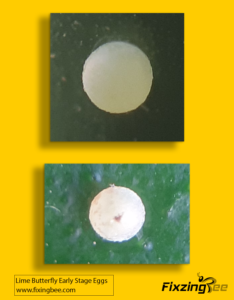
The first picture of this photo is the newest egg. It looks plain white on the first day. The second one is the second days’ egg. On this day a black spot appears on the egg. Thus the egg becomes mature.
Older Stage eggs:

This is called the final stage of the butterfly egg. At this stage, the egg looks black or brown according to the caterpillar’s body color. After this stage, the caterpillar hatches.
The Second Stage: (Caterpillar Phase)-
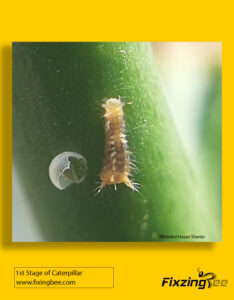
It takes 2 or 3 days to hatch a butterfly egg. After hatching from the egg the young caterpillar eats its own mature egg. The caterpillar eats a lot. They are called the eating machine and they eat their host plant’s leaf. They eat frequently and grow quickly. The metamorphosis of a caterpillar happens step by step. Each development is called an instar.
1st Instar Caterpillar:
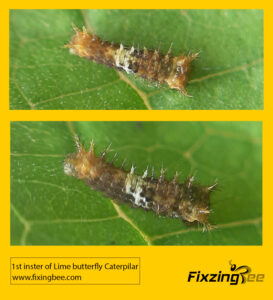
On the first instar caterpillars, a greenish-white patch appears on the middle of the caterpillars’ bodies. At this instar, the caterpillar grows up to 5mm. After 2/3 days later the greenish-white patch becomes more prominent and then molts into the next instar. The caterpillar lost its previous skin when it turns into a new instar.
2nd Instar caterpillar:
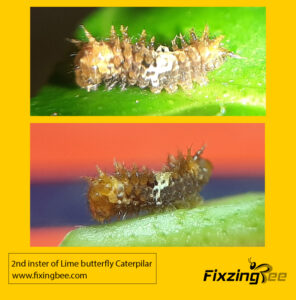
The second instar is close similar to the first instar. There is no major metamorphosis between these two instars but the white shade becomes more prominent at this instar. Before transforming the next instar the caterpillar becomes minimus 10mm in length. The caterpillar needs 2 days to molt into the next instar.
3d Instar Caterpillar:
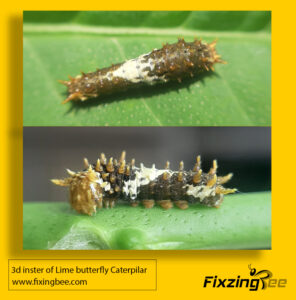
At this instar, a major metamorphosis is seen. The white patch becomes more extended and on the anterior and posterior body segments, a new white patch appears prominently. The body length reaches 16mm at this instar.
4th Instar:
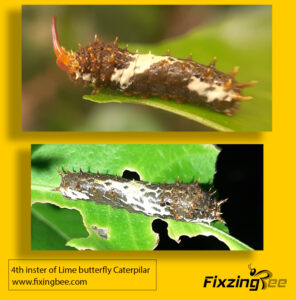
The body color becomes darker than the previous instar. Every instar goes two-stage instar. The first-day instar and the second days’ instar. The first day or the molted days instar is called early-stage instar and the second days’ instar is called final stage instar. The first picture indicates the first day’s instar and the second picture is the final stage caterpillar.
5th Instar:
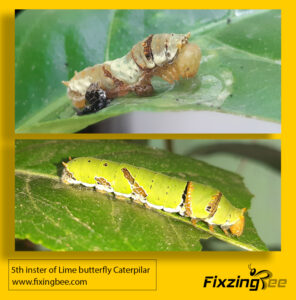
This is the final instar of a caterpillar. In this instar, the body color turns green. A pair of lateral eye spots appear. After completing this stage butterfly goes for the next step. A silk white layer is also seen at this instar. And this is the end of the instar processing.
The Third Stage: (Pupa/Chrysalis)-
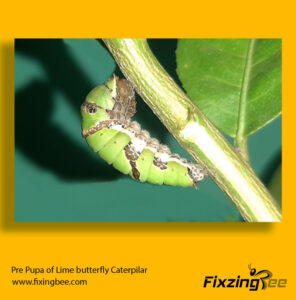
Pre Pupa Stage:
At this stage, the caterpillar starts preparing for the pupa. Caterpillar stops eating at this stage. This process doesn’t last a long time. The caterpillar produces silk quickly and turns into a pupa.
Pupa Stage:
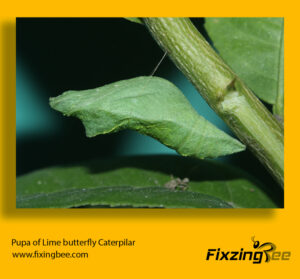
This is how a pupa looks like. Depending on the weather pupa can be black or green in color. Each pupa contains a pair of cephalic horns and a dorsal thoracic hump. The length of the pupa is different in size depending on the species. The length of Lime Butterfly is approximately 30-32mm.
Mature Pupa Stage:
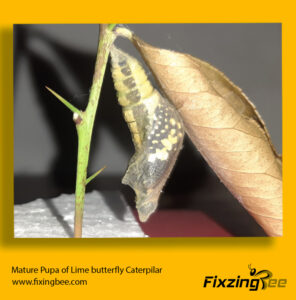
The pupa of the Lime Swallowtail butterfly comes to the end after 9 days. But this period could be different relying on different species. In this chrysalis, the butterfly is fully formed. The skin of the pupa starts to get thin at this time and Butterflies wings’ color can be seen in this mature pupa section.
You will be surprised to know that “The pupa stage may last for just a couple of days or it may last for more than a year depending on the species of butterfly.”
The Fourth Stage: (Adult Butterfly)-
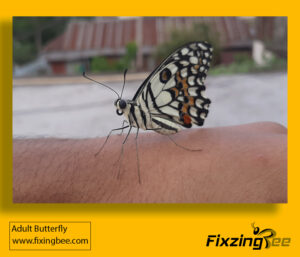
The adult butterfly is the final stage of a butterfly’s life cycle. If you ever observe a butterfly’s life cycle then you will come to know that the butterfly wings remain wet and wrinkled when they emerge from the chrysalis. It needs a few moments to make the wings hard and dry before they can fly. They can only fly when the wings become dry. This is how a butterfly life cycle continues.